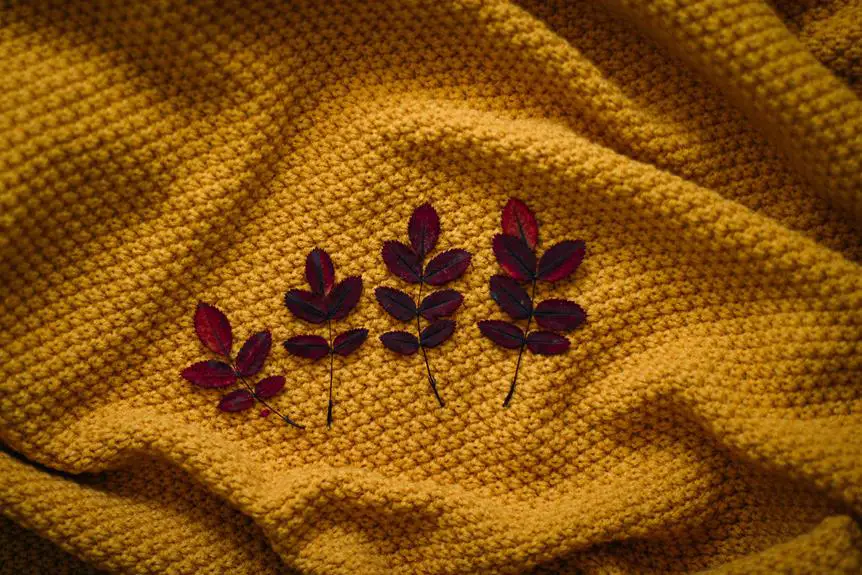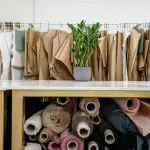If you've ever heard the saying, 'Different strokes for different folks,' then you'll understand the importance of choosing the right fabric weaving type for your project.
Each weaving type offers its own unique characteristics and strengths. Understanding the intricacies of plain weave, twill weave, satin weave, basket weave, dobby weave, jacquard weave, and leno weave will empower you to create fabrics that best suit your needs.
Let's delve into the world of fabric weaving to discover which weaving type is best for you.
Key Takeaways
- Plain weave is a popular choice for its strength and durability, making it suitable for workwear and durable home textiles.
- Satin weave offers a smooth and lustrous finish, making it ideal for evening gowns and formal attire.
- Basket weave provides exceptional durability and is suitable for upholstery and home decor.
- Jacquard weave allows for intricate and complex patterns, adding elegance and sophistication to any project.
Plain Weave
If you regularly wear durable and versatile fabrics, plain weave is ideal for you. This weaving technique is known for its strength and durability, making it perfect for everyday clothing that needs to withstand regular wear and tear. The tight, simple crisscross pattern of plain weave contributes to its resilience, ensuring that the fabric holds up well over time. Additionally, plain weave fabrics are highly versatile, suitable for a wide range of garments and household items. Whether you need a sturdy material for workwear or want to create durable home textiles, plain weave offers the necessary durability.
When comparing plain weave to twill weave, the fabric texture is a key distinguishing factor. While plain weave creates a flat, uniform surface, twill weave produces a diagonal rib pattern. This difference in texture can impact the appearance and drape of the fabric, as well as its overall durability. Despite these variations, plain weave remains a popular choice for those who prioritize strength and longevity in their textiles.
Twill Weave
When it comes to fabric weaving, the twill weave is a versatile option that offers distinct characteristics.
You'll find that twill weave fabrics have a diagonal pattern, making them durable and resistant to wrinkles.
In addition to its strength, twill weave is commonly used in applications such as denim, chino, and tweed, making it suitable for both casual and formal attire.
Twill Weave Characteristics
To determine if twill weave is best for your needs, assess its distinct diagonal pattern and durable nature.
Twill weave characteristics include a diagonal rib pattern formed by interlacing yarns, making it distinguishable from other weaves. This unique pattern gives twill fabrics a structured and textured appearance, adding depth to the material.
Additionally, twill weave's tight construction contributes to its fabric durability, making it resistant to wear and tear. The durable nature of twill weave makes it an ideal choice for heavy-duty applications, such as workwear and upholstery.
Furthermore, twill weave's textile design versatility allows for a range of finishes, from soft and drapable to sturdy and robust, making it suitable for various garment and home furnishing applications.
Twill Weave Applications
Once you understand the characteristics of twill weave, you can easily identify its various applications in both garment and home furnishing industries. Twill weave's strength and durability make it an ideal choice for a wide range of products. Here are some applications to consider:
- Garments:
- Durable workwear: Twill weave's strength makes it perfect for workwear such as jackets, pants, and coveralls, providing longevity and protection in demanding environments.
- Fashionable denim: The diagonal pattern variations in twill weave create stylish denim jeans and jackets that aren't only fashionable but also sturdy and long-lasting.
- Home Furnishings:
- Upholstery: Twill weave is often used for heavy-duty upholstery fabrics, offering both durability and an attractive texture.
- Drapery: Its strength and drapeability make twill weave an excellent choice for drapery fabrics, providing a luxurious look and feel while maintaining longevity.
Satin Weave
If you're looking for a fabric that offers a smooth and lustrous finish, the satin weave might be the perfect choice for you.
This weaving type drapes elegantly and luxuriously, making it well-suited for clothing and linens.
Its versatility and luxurious appearance make it a popular choice for various projects.
Smooth and Lustrous Finish
When choosing the best fabric weaving type for you, consider the smooth and lustrous finish of satin weave, which offers a luxurious and elegant appearance.
Satin weave, often associated with silk fabric, creates a stunning visual effect with its high sheen and glossy surface. Imagine the way light effortlessly glides over the fabric, creating a mesmerizing play of shadows and highlights.
Picture the soft, supple drape of the fabric as it gracefully conforms to the body, making it an ideal choice for evening gowns or formal attire.
Envision the touch of the fabric, smooth and cool against the skin, adding a sense of opulence and sophistication to any garment.
With its exquisite finish and versatility, satin weave is a timeless choice for those seeking a refined and polished look.
Drapes Elegantly and Luxuriously
Consider how satin weave fabric drapes elegantly and luxuriously, enhancing the overall look and feel of the garment with its smooth and lustrous finish. The satin weave is characterized by its glossy surface and dull back, creating a luxurious textile that reflects light beautifully.
This weaving technique uses long floats on the fabric's surface, giving it a soft, supple drape that falls gracefully, making it an ideal choice for elegant drapery. The way satin weave fabric hangs and moves adds a touch of sophistication and opulence to any garment. Its fluidity and ability to catch and reflect light create a sense of luxury that's unparalleled.
When you want your clothing to exude an air of refinement and elegance, choosing a satin weave fabric ensures that your garment will drape elegantly and exude a luxurious aura.
Versatile for Clothing and Linens
Satin weave fabric is versatile for clothing and linens, frequently adding a touch of sophistication and opulence to your wardrobe and home decor.
When considering linens, satin weave fabrics made from cotton offer a crisp, clean feel, while linen options provide a lightweight and airy texture.
In terms of clothing, cotton satin weave is breathable and ideal for warm weather garments, while its durability makes it suitable for everyday wear. Linen satin weave, on the other hand, offers exceptional breathability, making it perfect for summer clothing.
When it comes to durability, cotton satin weave is known for its strength, while linen satin weave tends to be more delicate.
Whether you prioritize breathability or durability, there's a satin weave fabric to suit your needs.
Basket Weave
If you're looking for a durable and textured fabric, basket weave might be the best choice for your project. The basket weave pattern offers several benefits, including exceptional durability. This weaving style creates a dense, tightly woven fabric that's less likely to snag or tear, making it an excellent option for upholstery and home decor.
Due to its sturdiness, basket weave fabrics are particularly suitable for high-traffic areas in your home, ensuring longevity and resilience.
When used for upholstery, basket weave fabrics can withstand everyday wear and tear, making them an ideal choice for furniture that sees frequent use. Additionally, the textured nature of the basket weave can add depth and visual interest to your home decor, creating a cozy and inviting atmosphere.
Whether you're looking to reupholster a sofa or incorporate durable yet stylish fabrics into your interior design, basket weave offers a versatile and practical solution. Its strength and resilience make it a reliable option for those seeking long-lasting and visually appealing fabric choices for their projects.
Dobby Weave
Looking for a fabric with intricate patterns and texture? If so, you might find the dobby weave particularly appealing. The dobby weave is a modern fabric design that creates eye-catching patterns and textures. Here's what to expect from this weaving technique:
- Intricate Patterns: The dobby weave is known for its intricate patterns, often featuring geometric shapes, small motifs, or textured designs. These patterns are created by using a special dobby loom that allows for small, individual warp threads to be raised or lowered, resulting in unique and intricate designs.
- Textured Finish: Dobby-woven fabrics often have a textured finish due to the variation in the weave structure. This textured surface adds depth and visual interest to the fabric, making it a popular choice for adding dimension to garments and home textiles.
- Versatile Applications: Due to its ability to create complex patterns and textures, dobby-woven fabrics are used in a wide range of applications, including dress shirts, blouses, curtains, and decorative upholstery.
The dobby weave offers a contemporary and stylish option for those seeking fabrics with dynamic visual appeal and sophisticated texture.
Jacquard Weave
Consider jacquard weave for intricate and elaborate fabric designs with a variety of textures. This weaving technique, named after its inventor Joseph Marie Jacquard, revolutionized fabric technology in the early 19th century.
What sets jacquard weave apart is its ability to create intricate patterns and designs that would be impossible with other weaving methods. The jacquard loom uses a series of punch cards to control individual yarns, allowing for the creation of complex patterns. This historical innovation paved the way for modern applications in textiles, including luxurious brocade fabrics, intricate damasks, and elegant tapestries.
In modern times, jacquard weave continues to be a hallmark of high-quality fabrics, favored for its ability to produce detailed and multi-dimensional designs. This weaving technique is often utilized in upholstery, curtains, and fashion fabrics, adding a touch of sophistication and elegance to any design.
Whether you're drawn to the rich history of jacquard weave or the allure of its modern applications, exploring this intricate weaving method can open up a world of possibilities for your fabric creations.
Leno Weave
To achieve an open, breathable fabric with unique twisted yarns, you should explore the leno weave technique. Leno weave benefits include a distinctive texture that sets it apart from other weaving methods. The leno weave creates a strong, durable fabric with a characteristic open construction, making it ideal for applications requiring breathability and a decorative touch.
The leno weave technique involves crossing warp yarns over each other in a figure-eight pattern, creating a twisted effect that adds strength and stability to the fabric. This unique interlacing of yarns results in a distinctively textured fabric, making it suitable for creating visually interesting garments and home textiles.
The open structure of leno weave fabric allows for excellent airflow, making it a popular choice for items like curtains, light scarves, and warm-weather clothing.
Leno weave finds applications in both decorative and functional use. Its unique texture and breathability make it a versatile choice for a wide range of products, from fashion to interior design. Whether you're looking to add an eye-catching element to your wardrobe or seeking a fabric that balances aesthetics with utility, the leno weave technique offers a compelling solution.
Frequently Asked Questions
How Do Different Weaving Types Affect the Durability and Lifespan of the Fabric?
Different weaving types directly impact fabric durability and lifespan. Understanding how weaving patterns like plain, twill, or satin affect strength and wear resistance is crucial to selecting the best fabric for your needs.
Are There Specific Weaving Types That Are Better for Certain Types of Clothing or Products?
When it comes to clothing applications, functional textiles, performance wear, and home decor, specific weaving types can enhance durability, breathability, and texture. Consider twill for sturdy bottoms, satin for luxurious tops, and plain weave for versatile home decor.
Can the Weaving Type Affect the Texture or Feel of the Fabric?
Yes, weaving types significantly impact fabric texture and feel. Twill weaves create a diagonal texture, while plain weaves result in a smooth, even feel. Consider weaving types for fabric durability, product suitability, and environmental impact.
Are There Any Environmental or Sustainability Considerations to Take Into Account When Choosing a Weaving Type?
When choosing a weaving type, consider the environmental impact and sustainable production. Look for options like organic cotton, linen, or hemp which require less water and fewer chemicals, contributing to a more eco-friendly choice.
How Do the Various Weaving Types Impact the Drape and Appearance of the Fabric?
Different weaving types have varying impacts on fabric drape and appearance. They influence drapability, visual aesthetics, and structural integrity based on the weaving pattern and fabric weight. Understanding these effects can help you choose the right type for your needs.
- Everything You Need to Know About Herringbone Denim Fabric - June 19, 2025
- Red Herringbone Fabric: Making a Bold Statement in Fashion and Decor - June 19, 2025
- Styling a Room Around a Herringbone Fabric Chair - June 19, 2025




